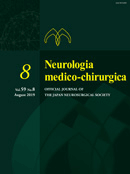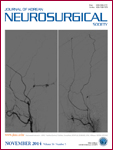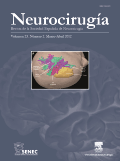
Egyptian Journal of Neurosurgery
Scope & Guideline
Bridging Research and Practice in Neurosurgery
Introduction
Aims and Scopes
- Clinical Neurosurgery:
The journal extensively covers clinical studies and case reports that highlight various surgical techniques, patient management strategies, and outcomes in neurosurgery. - Neurotrauma and Neurocritical Care:
A significant focus is placed on traumatic brain injuries, spinal cord injuries, and their management, emphasizing the importance of timely and effective interventions. - Neuro-oncology:
The journal features research on brain tumors, including gliomas and metastases, addressing surgical approaches, treatment outcomes, and advancements in therapeutic strategies. - Spinal Disorders:
Research on spinal pathologies such as degenerative diseases, tumors, and congenital malformations is prevalent, exploring surgical techniques and rehabilitation outcomes. - Innovative Technologies in Neurosurgery:
The journal showcases the integration of advanced technologies, including minimally invasive techniques, robotics, and imaging modalities that enhance surgical precision and patient safety. - Multidisciplinary Approaches:
Emphasizing collaboration among various specialties, the journal includes studies that incorporate input from radiology, oncology, rehabilitation, and other fields in managing neurosurgical patients.
Trending and Emerging
- Artificial Intelligence and Big Data:
There is a growing interest in the application of AI and big data analytics in neurosurgery, particularly in improving diagnostic accuracy and personalizing treatment plans for patients. - Minimally Invasive Techniques:
The trend towards minimally invasive surgical approaches is evident, with an increasing number of studies focusing on techniques that reduce recovery time and improve patient outcomes. - Patient-Centered Outcomes:
Recent articles emphasize the importance of patient-reported outcomes and quality of life measures, indicating a shift towards more holistic approaches in evaluating surgical success. - Neurosurgical Complications and Risk Management:
There is an emerging focus on understanding and managing complications associated with neurosurgical procedures, highlighting the need for improved patient safety protocols. - Neurorehabilitation and Postoperative Care:
Research on postoperative rehabilitation strategies and their impact on recovery is gaining prominence, reflecting a broader understanding of patient care beyond the operating room.
Declining or Waning
- Traditional Neurosurgical Techniques:
There appears to be a decline in the publication of studies focusing on conventional neurosurgical techniques, as the field shifts toward more minimally invasive and technologically advanced methods. - Basic Neuroscience Research:
Basic science studies in neurosurgery, such as neuropathology or neurobiology without direct clinical application, seem to be less frequently represented, possibly due to a focus on translational research. - Historical Perspectives in Neurosurgery:
Papers exploring historical practices or retrospective analyses of older techniques are becoming less common as the journal emphasizes contemporary practices and innovations. - Pediatric Neurosurgery:
Although still important, the volume of studies specifically addressing pediatric cases and their unique challenges appears to be diminishing compared to adult neurosurgical topics. - Neurosurgical Education and Training:
The focus on educational methods and training within neurosurgery is less prevalent, possibly reflecting a shift towards more practical, outcome-based studies rather than theoretical discussions.
Similar Journals

ACTA NEUROCHIRURGICA
Elevating Knowledge in the Art and Science of Neurosurgery.ACTA NEUROCHIRURGICA, published by Springer Wien, stands as a pivotal resource in the realms of neurology and surgery. With its long-standing tradition dating back to 1950, this esteemed journal not only contributes to the advancement of clinical neurology but also excels in surgical methodologies, evidenced by its impressive ranking in the Q1 category for Surgery and Q2 for Neurology (Clinical). With a robust Scopus ranking placing it in the top 20% of surgery journals and the 55th percentile in clinical neurology, it demonstrates a significant impact within its field. Researchers, professionals, and students alike benefit from its rigorously peer-reviewed articles that encompass a wide scope of both theoretical and practical insights. Although not an open-access journal, ACTA NEUROCHIRURGICA remains essential for anyone committed to keeping up with the latest discoveries and innovations in neurosurgery and neuroscience. Located in the heart of Austria at Prinz-Eugen-Strasse 8-10, A-1040 Vienna, this journal continues to be a cornerstone for scholarly communication, guiding future research directions and fostering collaborations among experts.

NEUROSURGICAL REVIEW
Uncovering breakthroughs in neurosurgery for practitioners and researchers.NEUROSURGICAL REVIEW is an esteemed journal dedicated to advancing the field of neurosurgery, published by Springer, one of the leading global publishers in academic research. With a distinguished history dating back to 1978, this influential journal serves as a vital resource for researchers, practitioners, and students, providing a platform for high-quality original research, case studies, and reviews that push the boundaries of knowledge in neurosurgery. The journal enjoys a remarkable reputation, holding a Q1 ranking in Medicine (miscellaneous) and Surgery, alongside a robust Q2 in Clinical Neurology as reported in 2023. Furthermore, it is recognized in Scopus with notable rankings, placing it in the 88th percentile in Surgery and the 68th percentile in Clinical Neurology. Although it does not offer open access, NEUROSURGICAL REVIEW remains pivotal in disseminating critical findings and fostering collaboration within the neuroscience community. As it continues to evolve through its convergence years up to 2024, the journal aims to address emerging challenges and innovations in the field, making it an essential publication for anyone involved in neurosurgical research and practice.

NEUROLOGIA MEDICO-CHIRURGICA
Bridging Disciplines for Innovative Medical InsightsNEUROLOGIA MEDICO-CHIRURGICA, published by the JAPAN NEUROSURGICAL SOCIETY, stands as a vital resource in the fields of neurology and surgery, featuring an impressive track record since its inception in 1959. With both an ISSN 0470-8105 and E-ISSN 1349-8029, this journal has embraced an Open Access model since 2000, ensuring that cutting-edge research and clinical advances are readily accessible to a global audience. The journal is currently ranked in the Q2 quartile for Neurology (clinical) and the prestigious Q1 quartile for Surgery as of 2023, highlighting its impact within these disciplines. With Scopus rankings placing it at #145 in Surgery and #206 in Neurology, NEUROLOGIA MEDICO-CHIRURGICA continues to play a crucial role in advancing medical knowledge, making it an indispensable reference for researchers, clinicians, and students alike. The journal's broad scope encompasses both clinical neurology and surgical techniques, positioning it at the forefront of interdisciplinary collaboration in the ever-evolving field of neurosurgery.

Journal of Korean Neurosurgical Society
Connecting Clinical Practice with Cutting-Edge DiscoveriesThe Journal of Korean Neurosurgical Society, with its ISSN 2005-3711 and E-ISSN 1598-7876, stands as a paramount resource in the field of neurosurgery, bridging clinical practice and cutting-edge research in both neurology and multidisciplinary neuroscience. Published by the Korean Neurosurgical Society, this open-access journal has been committed to disseminating invaluable knowledge to the global scientific community since its establishment in 1972. Located in Seoul, South Korea, the journal underscores its prominence with impressive quartile rankings—Q3 in Neurology (Clinical), Q3 in Neuroscience (Miscellaneous), and Q2 in Surgery for 2023. Its standing in Scopus rankings further emphasizes its impact, with a ranking of #195/551 in Medicine: Surgery and #235/400 in Medicine: Neurology (Clinical). By fostering a platform for innovative findings and advancements in surgical techniques, the Journal of Korean Neurosurgical Society aims to support professionals, researchers, and students alike in their pursuit of excellence and knowledge in neurosurgery and related fields, ensuring a brighter future for patient care and scientific inquiry.

NEUROSURGERY
Uncovering Breakthroughs in Neurosurgical Science.NEUROSURGERY, published by Lippincott Williams & Wilkins, stands as a foremost journal in the field of clinical neurology and surgery, reflecting a commitment to advancing knowledge and practice through high-quality research and discourse. With an impact factor indicative of its scholarly significance and a remarkable Scopus ranking placing it in the Q1 category for both neurology and surgery, this journal provides a vital platform for clinicians, researchers, and students to explore cutting-edge developments and innovations. NEUROSURGERY publishes peer-reviewed articles that span the spectrum of neurosurgical practice, from basic science discoveries to clinical applications, fostering a collaborative exchange of ideas and methodologies. Since its inception in 1977, the journal has maintained a focus on delivering substantive research that informs practice and enhances patient care, making it an essential resource for professionals dedicated to the fields of neurology and surgery. The journal is based in India, and while it currently does not offer open access options, its rich archive from 1977 to 2024 ensures a comprehensive repository of knowledge for those engaged in this critical area of medicine.

NEUROCIRUGIA
Unveiling new horizons in neurosurgical research.NEUROCIRUGIA, published by ELSEVIER ESPANA SLU, is a prominent journal in the fields of Neurology and Surgery, serving as a critical resource for researchers, clinicians, and students alike. With an ISSN of 1130-1473 and an E-ISSN of 2340-6305, this esteemed publication offers a platform for the dissemination of innovative research findings, clinical practices, and insights into the evolving challenges of neurosurgery. While the journal is currently categorized in the Q3 quartile within both Neurology (clinical) and Surgery disciplines, it continues to enhance its impact through rigorous peer review and a commitment to accessibility, despite not offering open access. NEUROCIRUGIA has a rich historical background, covering converged years from 1972 to 1980, 1990 to 1995, and continuously from 1999 to 2024. With its strong position in the Scopus rankings, being placed in the 41st and 23rd percentiles in the respective categories, the journal not only reflects the current needs within neurological and surgical research but also invites contributions that push the boundaries of knowledge in these critical areas of medicine.

Journal of Neurological Surgery Reports
Pioneering insights for the future of neurological healthcare.The Journal of Neurological Surgery Reports, published by GEORG THIEME VERLAG KG, serves as a pivotal platform for groundbreaking research in the field of neurological surgery. As an Open Access journal since 2012, it ensures that vital findings are accessible to a global audience, thereby promoting knowledge sharing and collaboration among researchers, clinicians, and students alike. With an ISSN of 2193-6358 and an E-ISSN of 2193-6366, this journal consistently ranks within the 41st percentile in the field of Medicine & Surgery and the 26th percentile in Medicine & Neurology (Clinical) according to Scopus, highlighting its commitment to quality and relevance. The journal's focus encompasses a wide spectrum of topics within neurological surgery, encouraging submissions that advance understanding and treatment of neurological conditions. By fostering a rich scientific discourse, the Journal of Neurological Surgery Reports plays an essential role in shaping the future of neurological healthcare.

Brain and Spine
Advancing insights into the intricate interplay of brain and spine.Brain and Spine is a premier academic journal published by ELSEVIER, dedicated to advancing the fields of neuroscience and neurology. With its unique focus on the complex interactions between brain function and spinal health, this journal serves as an essential resource for researchers, clinicians, and students alike. Though currently lacking an official impact factor, its ranking within Scopus highlights its relevance, placing it in the 25th percentile for neuroscience (miscellaneous) and the 23rd percentile within neurology, indicating that while it is a developing journal, it holds potential for significant contributions to the field. Operating under open-access principles, it aims to disseminate valuable findings widely, ensuring that novel insights into neurological health are accessible to a global audience. Brain and Spine seeks to foster interdisciplinary collaboration and innovation, making it an invaluable platform for those striving to enhance our understanding of the brain and spinal cord's intricate functions and interdependencies.

Operative Neurosurgery
Unveiling Breakthroughs in Operative Neurosurgery.Operative Neurosurgery is a distinguished peer-reviewed journal published by Lippincott Williams & Wilkins, focusing on the rapidly evolving fields of neurology and surgery. With an ISSN of 2332-4252 and an E-ISSN of 2332-4260, this journal serves as a vital platform for disseminating high-quality research, clinical studies, and innovative practices from 2012 through 2024. As of 2023, it holds a reputable position in category quartiles—Q3 in clinical neurology and Q2 in surgery—demonstrating its commitment to contributing to the scientific community. The journal's placement in the Scopus rankings also reflects its significance, with a ranking of #177 out of 551 in surgery and #229 out of 400 in clinical neurology. Although it operates under a traditional subscription model, the journal remains dedicated to enhancing access to pivotal information that shapes operative techniques and patient outcomes, making it an essential resource for researchers, surgeons, and clinicians alike. Through rigorous peer review and a commitment to academic integrity, Operative Neurosurgery invites contributions that advance knowledge and foster further exploration within these crucial fields.

BRITISH JOURNAL OF NEUROSURGERY
Exploring the forefront of neurosurgical excellence.Welcome to the British Journal of Neurosurgery, a premier interdisciplinary publication dedicated to advancing the field of neurosurgery and enhancing clinical practice. Published by Taylor & Francis Ltd, this esteemed journal features a rich repository of peer-reviewed research covering innovative methodologies, case studies, and evidence-based practices across neurology and surgery. With an ISSN of 0268-8697 and an E-ISSN of 1360-046X, the journal is indexed in notable databases, reflecting a commendable standing in academia, categorized in Q2 for Surgery and Q3 for Medicine and Clinical Neurology as of 2023. Although currently not offering Open Access, the British Journal of Neurosurgery retains a readership of researchers, clinicians, and students eager for the latest insights impacting patient outcomes and surgical techniques. With an aim to bridge scientific inquiry and practical application, this journal plays an essential role in the global neurosurgical community, making significant contributions from its base in the United Kingdom.